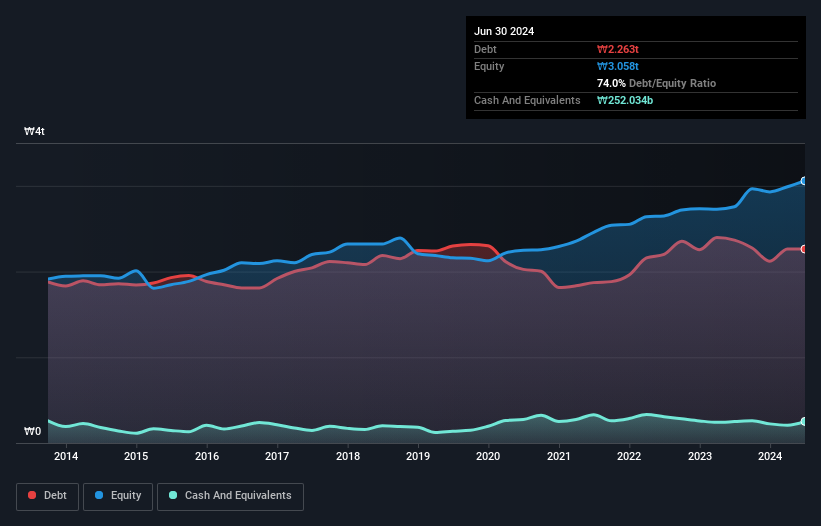- South Korea
- /
- Chemicals
- /
- KOSE:A120110
Here's Why Kolon Industries (KRX:120110) Is Weighed Down By Its Debt Load
Warren Buffett famously said, 'Volatility is far from synonymous with risk.' When we think about how risky a company is, we always like to look at its use of debt, since debt overload can lead to ruin. As with many other companies Kolon Industries, Inc. (KRX:120110) makes use of debt. But should shareholders be worried about its use of debt?
What Risk Does Debt Bring?
Generally speaking, debt only becomes a real problem when a company can't easily pay it off, either by raising capital or with its own cash flow. In the worst case scenario, a company can go bankrupt if it cannot pay its creditors. While that is not too common, we often do see indebted companies permanently diluting shareholders because lenders force them to raise capital at a distressed price. Of course, plenty of companies use debt to fund growth, without any negative consequences. When we examine debt levels, we first consider both cash and debt levels, together.
View our latest analysis for Kolon Industries
What Is Kolon Industries's Net Debt?
You can click the graphic below for the historical numbers, but it shows that Kolon Industries had ₩2.26t of debt in June 2024, down from ₩2.37t, one year before. However, it also had ₩252.0b in cash, and so its net debt is ₩2.01t.

A Look At Kolon Industries' Liabilities
Zooming in on the latest balance sheet data, we can see that Kolon Industries had liabilities of ₩2.44t due within 12 months and liabilities of ₩742.7b due beyond that. On the other hand, it had cash of ₩252.0b and ₩869.6b worth of receivables due within a year. So it has liabilities totalling ₩2.07t more than its cash and near-term receivables, combined.
This deficit casts a shadow over the ₩1.07t company, like a colossus towering over mere mortals. So we definitely think shareholders need to watch this one closely. At the end of the day, Kolon Industries would probably need a major re-capitalization if its creditors were to demand repayment.
In order to size up a company's debt relative to its earnings, we calculate its net debt divided by its earnings before interest, tax, depreciation, and amortization (EBITDA) and its earnings before interest and tax (EBIT) divided by its interest expense (its interest cover). The advantage of this approach is that we take into account both the absolute quantum of debt (with net debt to EBITDA) and the actual interest expenses associated with that debt (with its interest cover ratio).
Weak interest cover of 2.2 times and a disturbingly high net debt to EBITDA ratio of 5.1 hit our confidence in Kolon Industries like a one-two punch to the gut. The debt burden here is substantial. Worse, Kolon Industries's EBIT was down 32% over the last year. If earnings continue to follow that trajectory, paying off that debt load will be harder than convincing us to run a marathon in the rain. The balance sheet is clearly the area to focus on when you are analysing debt. But ultimately the future profitability of the business will decide if Kolon Industries can strengthen its balance sheet over time. So if you're focused on the future you can check out this free report showing analyst profit forecasts.
Finally, while the tax-man may adore accounting profits, lenders only accept cold hard cash. So we always check how much of that EBIT is translated into free cash flow. During the last three years, Kolon Industries burned a lot of cash. While investors are no doubt expecting a reversal of that situation in due course, it clearly does mean its use of debt is more risky.
Our View
To be frank both Kolon Industries's EBIT growth rate and its track record of staying on top of its total liabilities make us rather uncomfortable with its debt levels. And furthermore, its net debt to EBITDA also fails to instill confidence. It looks to us like Kolon Industries carries a significant balance sheet burden. If you harvest honey without a bee suit, you risk getting stung, so we'd probably stay away from this particular stock. There's no doubt that we learn most about debt from the balance sheet. However, not all investment risk resides within the balance sheet - far from it. We've identified 4 warning signs with Kolon Industries (at least 1 which shouldn't be ignored) , and understanding them should be part of your investment process.
At the end of the day, it's often better to focus on companies that are free from net debt. You can access our special list of such companies (all with a track record of profit growth). It's free.
Valuation is complex, but we're here to simplify it.
Discover if Kolon Industries might be undervalued or overvalued with our detailed analysis, featuring fair value estimates, potential risks, dividends, insider trades, and its financial condition.
Access Free AnalysisHave feedback on this article? Concerned about the content? Get in touch with us directly. Alternatively, email editorial-team (at) simplywallst.com.
This article by Simply Wall St is general in nature. We provide commentary based on historical data and analyst forecasts only using an unbiased methodology and our articles are not intended to be financial advice. It does not constitute a recommendation to buy or sell any stock, and does not take account of your objectives, or your financial situation. We aim to bring you long-term focused analysis driven by fundamental data. Note that our analysis may not factor in the latest price-sensitive company announcements or qualitative material. Simply Wall St has no position in any stocks mentioned.
About KOSE:A120110
Kolon Industries
Engages in industrial materials, chemicals, films/electronic materials, and fashion businesses in South Korea and internationally.
Moderate growth potential with mediocre balance sheet.
Market Insights
Community Narratives



